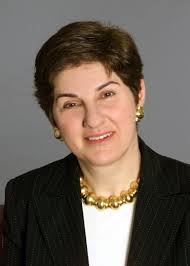Artificial intelligence and trading algorithms may have established a strong foothold in trading, but they still have a way to go before wide adoption in wealth management.
Investment managers’ fascination in using artificial intelligence, or pattern recognition theory, ebbs and flows, according to Sharmin Mossavar-Rahmani, chief investment officer, private wealth management group at Goldman Sachs.
“We think about artificial intelligence quite a lot,” she said in a Oct. 7 lecture at Stevens Institute of Technology in Hoboken, N.J., across the Hudson River from Manhattan. “However, there is something more important than just technology.”
Mossavar-Rahmani equates the use artificial intelligence with the mature discipline of technical analysis, which still divides the wealth management community.
“One member of our asset allocation team loves technicals, while others roll their eyes at its very mention,” she said. Among well-known investors, Paul Tudor Jones is a noted proponent of using technical charts and artificial intelligence to recognize pricing patterns, Mossavar-Rahmani said.
However, technical analysis and artificial intelligence are only as good as the data which their algorithms consume and their results can be affected by people’s behavioral biases, incomplete data series, or simply the wrong data.

Sharmin Mossavar-Rahmani, Goldman Sachs
Technical trading, like most trading strategies, are not bulletproof all the time, she added. “Take momentum trading. It works exceptionally well when there is great momentum up or down in the market, but it doesn’t work when the markets are choppy like today.”
Mossavar-Rahmani also recalled an investment strategy that a former colleague deployed, which relied on chaos theory. “He had a terrific track record for a brief period and everybody wanted to know what he was doing,” she remembered. “It worked for two or three years and then it was a disaster.”
Despite the limits of these investment strategies, Goldman Sachs continues to increase its technology investments significantly to support investment strategies, trading floors, and the firm’s cyber-security, she added.
Mossavar-Rahmani’s group manages the assets of Goldman Sachs’ highest-net-worth clients. The wealth management space is considered fertile ground for expanded use of quantitative tools and technology.
While quantitative tools can improve investment performance, it takes a skilled and analytical mind to reveal and act on the insights they provide. Practitioners must strike a balance the science behind the application of powerful investment data tools, and the art of interpreting the information they uncover.
Featured image by Kentoh/Dollar Photo Club




